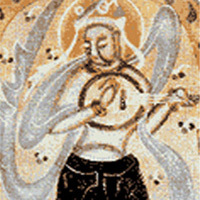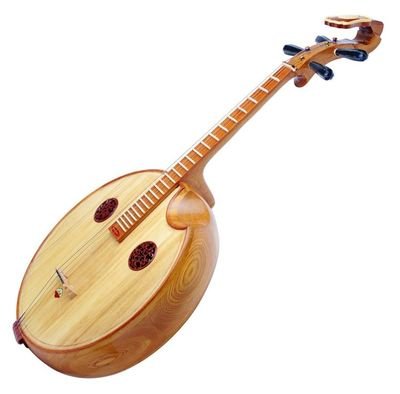The origin and history of Nguyen
In the Han Dynasty, many horse-mounted musical instruments were introduced into China. In the second year of Yuanding, Emperor Wu of the Han Dynasty (115 BC), Zhang Qian sent an envoy to the Wusun country (now the Uzbek nation), Wusun King Hunting Jiaomi and Han intermarriage, Princess Wusun Before his marriage, Emperor Wu of the Han Dynasty ordered craftsmen who knew music to create a musical instrument that could be played on a horse with reference to the qin, zheng, Zhu, and lying Konghou. It was Ruan, who was called "Qin Pipa" at that time.
The origin is different. According to the literature and historical data from the Han Dynasty to the Wei and Jin Dynasties, the Ruan is a kind of musical instrument with a round body, a straight item, four strings and 12 columns (freets) created by the Han people themselves. Originated from about 217 BC to 105 BC, it was called Qin Pipa or Qin Hanzi in the Han Dynasty.
Ruan Xian in the Western Jin Dynasty was good at playing this pipa, hence the name Ruan Xian. In the Tang Dynasty, the Quxiang Pipa, which was introduced to China from the Western Regions around 350 years ago, was popular and ranked first in the club. Gradually, the curved-neck pipa was called the pipa, and the straight-handled pipa was called Ruan Xian. Until the Qing Dynasty, although Ruan still maintained the ancient system, its range was only more than one octave.
Ruan Xian in the "Seven Sages of Bamboo Forest" in the Western Jin Dynasty (AD 266-316) was an outstanding musician, and he liked playing this instrument the most. Due to Ruan Xianshan's playing and the admiration of the seven sages in the bamboo forest at that time, this musical instrument became popular all over the country and became the main instrument for solo, ensemble or accompaniment of Xianghe songs. Later, due to social unrest, Ruan was once lost.
The picture shows the reliefs of the Maijishan Grottoes in Gansu and the frescoes of the Northern Wei Dynasty in Dunhuang.

Ruan had four strings and 13 columns in the Tang Dynasty, and the development was relatively complete. The great Tang Dynasty poet Bai Juyi once vividly described Ruan's tone in his poems as pure, thick and round. As sweet as a pearl falling on a jade plate. Ruan Xian was also one of the main musical instruments in the "Qingshang Music" and "Xiliang Music" of the Tang Dynasty.
At the end of the 10th century in the Song Dynasty, everyone in the Song Dynasty increased Ruan Xian from four strings to five strings, but did not call it Wu Xian Ruan Xian, but called it "Five Xian Ruan".
Then it developed into the Yuan Dynasty, and Ruan was widely spread among the people and became a favorite plucked instrument.
Until the Qing Dynasty, Ruan still maintained the ancient system, with a vocal range of only one more octave. The old-fashioned Ruan, which is popular in the folk, degenerates into two or three strings. Even if there are four strings, every two strings have the same tone. The range is very narrow and the scale is not complete.
After the founding of the People's Republic of China, Ruan's reform and performance art developed rapidly. In the 1950s, a series of reforms were carried out on Ruan, so that Ruan had four parts of treble, alto, tenor and bass, and became a family of its own. The reformed Ruandu has four strings, using metal strings, which is easy to tune, the sound range is extended to more than three octaves, and the volume is increased. The semitones are complete and can be adjusted arbitrarily. In terms of playing skills, in addition to traditional fingering, he also absorbed other Chinese and foreign plucked instruments, which greatly enriched Ruan's expressive power.

 渝公网安备 50010702504639号
渝公网安备 50010702504639号